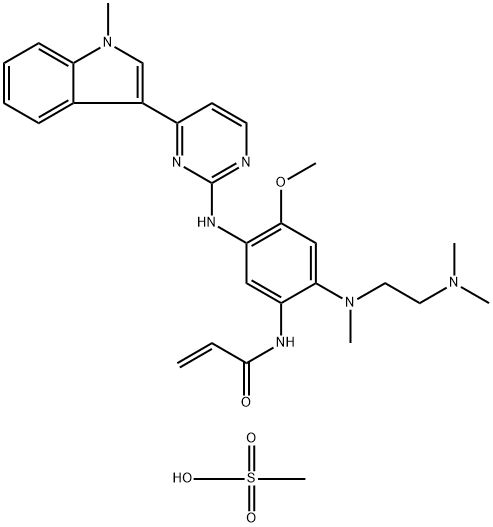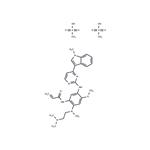
Osimertinib dimesylate
- Product NameOsimertinib dimesylate
- CAS2070014-82-1
- CBNumberCB05419799
- MFC29H37N7O5S
- MW595.72
- MOL File2070014-82-1.mol
Chemical Properties
| storage temp. | Store at -20°C |
| solubility | DMSO: 0.4 mg/mL (0.58 mM and warming) |
| form | Solid |
| color | Light yellow to yellow |
Osimertinib dimesylate Price
| Product number | Packaging | Price | Product description | Buy |
|---|---|---|---|---|
| ChemScene CS-3405 | 5mg | $60 | Osimertinibdimesylate 99.96% |
Buy |
| ChemScene CS-3405 | 10mg | $70 | Osimertinibdimesylate 99.96% |
Buy |
| ChemScene CS-3405 | 50mg | $100 | Osimertinibdimesylate 99.96% |
Buy |
| ChemScene CS-3405 | 100mg | $120 | Osimertinibdimesylate 99.96% |
Buy |
| ChemScene CS-3405 | 200mg | $140 | Osimertinibdimesylate 99.96% |
Buy |
Osimertinib dimesylate Chemical Properties,Usage,Production
Description
Osimertinib dimesylate (AZD-9291 dimesylate) is an irreversible and mutant selective EGFR inhibitor with IC50s of 12 and 1 nM against EGFRL858R and EGFRL858R/T790M, respectively. EGFRL858R|12 nM (IC50)|EGFRL858R/T790M|1 nM (IC50)
Osimertinib (AZD-9291) shows similar potency to early generation tyrosine kinase inhibitor (TKIs) in inhibiting EGFR phosphorylation in EGFR cells harboring sensitising EGFR mutants including PC-9 (ex19del), H3255 (L858R) and H1650 (ex19del), with mean IC50 values ranging from 13 to 54 nM for Osimertinib (AZD-9291). Osimertinib (AZD-9291) also potently inhibits phosphorylation of EGFR in T790M mutant cell lines (H1975 (L858R/T790M), PC-9VanR (ex19del/T790M), with mean IC50 potency less than 15 nM[1].
The tumor-bearing mice are treated with Osimertinib (AZD-9291) (5 mg/kg/day) for one to two weeks. Within days of treatment, 5 of 5 C/L858R mice displays nearly 80% reduction in tumor volume by magnetic resonance imaging MRI after therapy with Osimertinib (AZD-9291), while 5 of 5 mice treated with vehicle shows tumor growth[1]. Osimertinib (AZD-9291) demonstrates improved rat PK, reduced hERG affinity, and improved IGF1R margins relative to the previously described compounds, and so this compound is selected for further investigation. Osimertinib (AZD-9291) also offers an additional degree of broader chemical and profile diversity when compared to the previously described lead compounds. Upon dosing Osimertinib (AZD-9291) in three efficacy models, The comparable efficacy is observed at relatively low doses (10 mg/kg per day). The excellent efficacy is also observed when Osimertinib (AZD-9291) is dosed at 5 mg/kg per day[2].
References
[1]. Cross DA, et al. AZD9291, an irreversible EGFR TKI, overcomes T790M-mediated resistance to EGFR inhibitors in lung cancer. Cancer Discov. 2014 Sep;4(9):1046-61. [2]. Finlay MR, et al. Discovery of a potent and selective EGFR inhibitor (AZD9291) of both sensitizing and T790M resistancemutations that spares the wild type form of the receptor. J Med Chem. 2014 Oct 23;57(20):8249-67.
Preparation Products And Raw materials
Osimertinib dimesylate Suppliers
| Supplier | Tel | Country | ProdList | Advantage | |
|---|---|---|---|---|---|
| +1-781-999-5354 +1-00000000000 |
marketing@targetmol.com | United States | 32159 | 58 | |
| +1-708-310-1919 +1-13798911105 |
sales@invivochem.cn | United States | 6391 | 58 | |
| support@targetmol.com | United States | 38630 | 58 | ||
| +86-371-86557731 +86-13613820652 |
info@fdachem.com | China | 20241 | 58 | |
| tp@aladdinsci.com | United States | 52924 | 58 | ||
| +8613817748580 | cooperation@kean-chem.com | China | 40066 | 58 | |
| 022-60116533 13207668525 |
saleskc@scipharmacn.com | China | 634 | 58 | |
| 18149758185 18149758185 |
sales-cpd@caerulumpharma.com | China | 3466 | 58 | |
| 021-65675885 18964387627 |
info@efebio.com | China | 9803 | 58 | |
| 15076683720 | klq@cw-bio.com | China | 6039 | 55 |
2070014-82-1, Osimertinib dimesylateRelated Search
The What'sApp is temporarily not supported in mainland China
